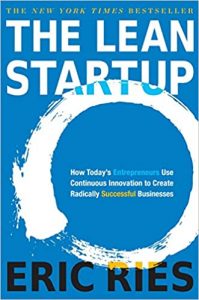fast and efficient > a mirror of our time
If you google `the Lean Startup´, you will get around 31 Million results.
There is a lot about describing it as a methodology, strategy or movement.
We think the best way to prescribe the Lean Startup is to see it as a ‘mirror of our time`. It underlines certain values that are becoming increasingly important in business as well as in our private lives. It reflects the speed of development and the constant pressure to deliver.
At first, I want to give a short overview.
The Lean Startup is one of the most successful entrepreneur guidelines these days.
Eric Ries, the founder of Lean Startup, defines a Startup as:
“A human institution designed to create something new under conditions of extreme uncertainty.”

Following this assumption, a Startup is every business, regardless of the size, which is dealing with uncertainty.
These companies do not know, for example, who their future customers will be, what these customers want and how they are going to build a sustainable business. They can only think up hypotheses and check them.
According to Ries the fastest way to solve these questions is to develop an MVP.
MVP is the abbreviation for minimum viable product and can be described as an initial product equipped only with the most necessary core functions. It can be seen as a prototype. After the MVP is released, the opinions of the very first customers should be gathered. These customers are called ‘Early Adapters’ and are usually very interested in new products and have a strong affinity for technology.
The collected data should be analysed in detail and conclusions are drawn accordingly, which will then be integrated into the product.
After the product is updated with the new features it is brought back on the market. This recurring cycle of programming, analysing, and improving the product is called the ‘build-measure-learn feedback loop’. This approach prevents the development of a product for which there is no need. It aims to help founders to quickly find out whether their concept works. If this is not the case, it can be restructured before young companies lose many thousands of euros or their entire existence.
As you can understand now the Lean Startup is designed to develop a product as quickly as possible that is used by as many people as possible. It shows the demands of our time to deliver the right thing ever faster. Especially in the IT industry this is an important issue. If too much time was spent on planning and development, by the time the product is launched, there might already be completely different solutions for the product or competitors might have been quicker.
However, this development is also reflected in private areas. Through social media we have to be constantly accessible and available. If we don’t answer for a while, our friend might be angry, or if we don’t look at tinder for a day, our crush might already have a new match and has reoriented him/herself. Since it reflects the current private as well as the economic conditions, the Lean Startup can be seen as a mirror of our current living conditions. This is a development that one can approve or not. But for sure it happens.
Following I want to elaborate some more characteristics of the Lean Startup method. Nowadays there are many business philosophies. So why does this article discuss the Lean Startup? Is there anything special about it and what makes it different compared to other business approaches?
⭐ What makes the Lean Startup so special? ⭐
What can be said with certainty is that the business model is very success oriented and the focus is clearly on sustainable resource use. But what is so special about this concept is that the success of the company comes with a product specialized for the customer. This ensures that many people have a benefit and their lives become easier. Even if the formulation is too often mentioned and unfortunately often misused, but in this case, there is clearly a win-win-situation – the advantage of the developer and the customer is ensured.
Furthermore, it tells us that basically all our assumptions about our potential customers might be wrong. In this context the difficulty between theory and practice is clearly addressed. The highly customer-oriented approach enables completely new processes and calls into question the long-standing assumption that extensive research and intensive planning are the sure success of a project. The Lean Startup approach is based on the assumption that we can never predict exactly who will be attracted by the innovation, what exactly these customers want and how the product and the business will develop. This can only be found out through repeated practical trials. Therefore, an innovation can also be understood as empirical research.
Another statement from Eric Ries claims that ‘Everything that doesn’t lead to validated learning is waste’. On one hand this shows the importance of the build-measure-learn circle and on the other hand it provides information on how the Lean Startup assesses failures. Learning also includes making necessary course corrections. If customer feedback shows that developments are going in the wrong direction, countermeasures must be taken. In this context we also speak of a ‘pivot’. So according to the Lean Startup failures are not a waste. You can and will have a lot of failures in the beginning, the important thing is that you recognize them and that you react and learn from them.
This brings us to another interesting point. The balance between pivot and persevere. Eric Ries claims that you must possess both. To know what you need to decide for you should establish a baseline of the current situation using an MVP. After that you can attempt to tune the MVP towards the ideal to multiple iterations in the build-measure-learn feedback loop. When you have completed these steps, you should choose between pivot or persevere. But don’t be afraid of the pivot. In fact, a lot of successful start-ups like e.g. Groupon have done a major change to their strategy! In the beginning their aim was to encourage people to donate and to engage in collective activities. But success failed, so a strategic reorientation was necessary. Today, Groupon appeals to all people worldwide who want to save money on certain services or events and has an annual turnover of 2.84 billion euros.
As already mentioned, the Lean Startup is aware of the fast moving IT scene. Unlike other business models, it does not ignore the speed, but is precisely adapted to it by the rapid development of the MVP. In this context Eric Ries notes ´The only way to win is to learn faster than anyone else´.
Another important point to mention is the flexibility of the Lean Startup. In any case, it will always be important to react quickly and flexibly to changes. After all, in times of short product life cycles, only flexible business models have the chance to establish themselves on the market sustainably.
In summary, it can be said that Lean Startup is the outcome of the ever faster developing technology and the performance-oriented society. This method recognizes and accepts many current developments of our time, incorporates them and provides appropriate answers to them. It avoids to develop a product that nobody wants to have, shortens development cycles and irrelevant assumptions are discovered quickly and cost-effectively through learning processes. Furthermore, it claims that all time is valuable and shouldn’t be wasted. But behind this performance-oriented focus is also a human one. Eric Ries assures for example that it is human to make mistakes, it is only important to recognize and react to them. All these principles make the Lean Startup so unique and valuable.
What do you think about the Lean Startup? Did you ever had experience in working lean?
Can’t wait to read your thoughts!




